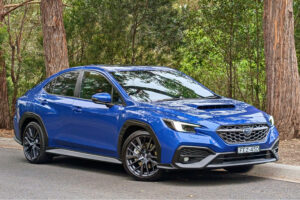Meet the latest SL sports machine from Mercedes-Benz, the SL 400. A sleek, modestly priced (these things are relative, but $229,000 is pretty good in this class) model continues the line that began with the legendary Mercedes SL 300 Gullwing over 60 years ago.
All German carmakers are rapidly switching to turbocharged engines as a necessary way of reducing emissions without hampering on-road performance. In fact we are rapidly reaching the time when nothing but turbo engines will be installed.
The SL 400 engine, is a 3.0-litre, turbo-petrol, V6. The ‘400’ is simply a number chosen by Mercedes to sort-of indicate the performance it provides, not the actual engine capacity.
It produces 245 kW of power and an impressive 480 Nm of torque. The latter is there from just 1600 rpm and remains at that peak (or should we say plateau?) until it gets to 4000 revs, even beyond that there’s still plenty of grunt on offer.
The V6 uses direct fuel-injection, Mercedes’ Bi-turbo boost system and engine stop-start to reduce fuel use. The official fuel consumption is 7.8 litres per hundred kilometres when measures on the Australian Design Rule (ADR) 81/02. That translates to 181 grams of CO2 per kilometres, European car taxes are very much affected by CO2 output and the 181 number is pretty good for a big sportscar.
Power is sent to the rear wheels through a seven-speed automatic transmission that can be operated as a full automatic, manual or sports modes.
During our initial drive program from Mercedes-Benz’s Airport Express facility at Tullamarine airport to the Yarra Valley by way of some superb driving roads we found the new engine to be nicely responsive. Perhaps not quite as quick on the throttle during the initial stages of acceleration when compared with the previous non-turbo unit, but once it does get on song it powers up impressively.
Mercedes quotes the zero to 100 km/h time as 5.2 seconds and we see no reason to doubt this. It has the sort of torque that lets you overtake safely with a minimum of time spent on the wrong side of the road. The exhaust note is more subdued than we like in a big sportscar, but the quality of sound is there even if the quantity is somewhat lacking to our ears.
Another great feature is the black glass sunroof that gives you a semi-open-air feel even if the weather is unkind and you can’t put the convertible top down. Or even in more mundane situations where there’s too much traffic noise and the roof shuts it out.
Though the big Mercedes SL is often regarded as a sportscar it should probably be seen as a grand tourer, which is what GT originally stood for. On our test drive we enjoyed the comfort of a big tourer with the ability to dispatch big distances with effortless ease and surprising comfort. The fact that the Harmon Kardon audio system has been upgraded and digital radio added, supports the fact that Mercedes-Benz is putting the emphasis on touring rather than bruising.











